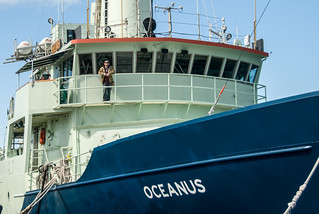 Oregon State University has been chosen to lead a project to design and build as many as three new coastal research vessels, the first multi-ship expansion of the National Science Foundation’s academic research fleet since the 1970s, and one intended to boost the marine science research capabilities of the United States.
Oregon State University has been chosen to lead a project to design and build as many as three new coastal research vessels, the first multi-ship expansion of the National Science Foundation’s academic research fleet since the 1970s, and one intended to boost the marine science research capabilities of the United States.
The new vessels, which could take a decade to design, build and equip, will become part of the University-National Oceanographic Laboratory System, the nationwide program which provides research-capable ships to universities which could not afford to build and own the vessels themselves in order to advance the nation’s marine science capacity.
OSU initially will receive nearly $3 million to coordinate the design phase of the project – and if funds are appropriated for all three vessels, the total grant is projected to reach $290 million over 10 years. The first phase of the project is scheduled to begin early this year. The final number of ships constructed, and where the vessels will be berthed, will be determined by the NSF based on geographic scientific requirements and availability of funding.
If all three vessels are built, it is likely that one each would be positioned on the East Coast, West Coast and Gulf Coast, officials say. As part of its proposal to lead the effort, OSU proposed to be the operator of the first vessel.
Distributing the vessels geographically allows scientists from all over the country to book research cruise time from locations nearest to the ocean and coastal areas they are studying.
The university now operates the R/V Oceanus, which replaced the R/V Wecoma when it was retired from service last year and sent away to be scrapped. Both vessels dated to the mid 1970s, and the Oceanus is expected to be ready for retirement about the time the new research vessels become available.
A project team led by Oregon State’s College of Earth, Ocean, and Atmospheric Sciences will finalize the design for the 175-foot long, technically enhanced Regional Class ships, select a shipyard, oversee construction, and coordinate the system integration, testing, commissioning and acceptance, and transition to operations.
“These will be floating, multi-use laboratories that are flexible and can be adapted for different scientific purposes, yet are more seaworthy and environmentally ‘green’ than previous research vessels,” said Mark Abbott, dean of the OSU College of Earth, Ocean, and Atmospheric Sciences. “These ships will be used to address critical issues related to climate change, ocean circulation, natural hazards, human health, and marine ecosystems.”
OSU vice president for research Rick Spinrad, who previously directed research programs for the U.S. Navy and the National Oceanic and Atmospheric Administration (NOAA), said the new vessels would “revitalize and transform” coastal ocean science in the United States.
“Many of the most pressing issues facing our oceans are in these coastal regions, including acidification, hypoxia, tsunami prediction, declining fisheries, and harmful algal blooms,” Spinrad said. “Because of their flexibility, these new vessels will attract a broad range of users and will become ideal platforms to training early-career scientists and mariners.”
The project had the support of Oregon Gov. John Kitzhaber’s Office, noted OSU President Ed Ray, who said the university will benefit from the process long before the first ship hits the water in 2019 or 2020.
The successful OSU proposal was submitted to the National Science Foundation by Clare Reimers, an oceanography professor, and Demian Bailey, the university’s marine superintendent. As part of that submission, OSU proposed to be the operator of the first vessel. Additional operating institutions will be determined once the total number of vessels to be built is known.
“The National Science Foundation hasn’t authorized a multi-ship project since the 1970s,” Bailey said, “and these are likely the only ships scheduled by NSF to be built during the next decade – so this is a big deal. The endurance and size of the new ships will be similar to that of Oceanus and Wecoma but they will be much more efficient and have far greater scientific capacity and flexibility.”

